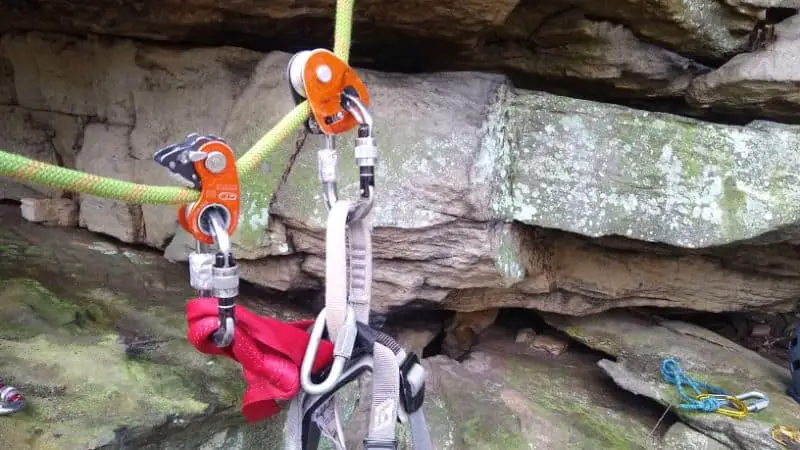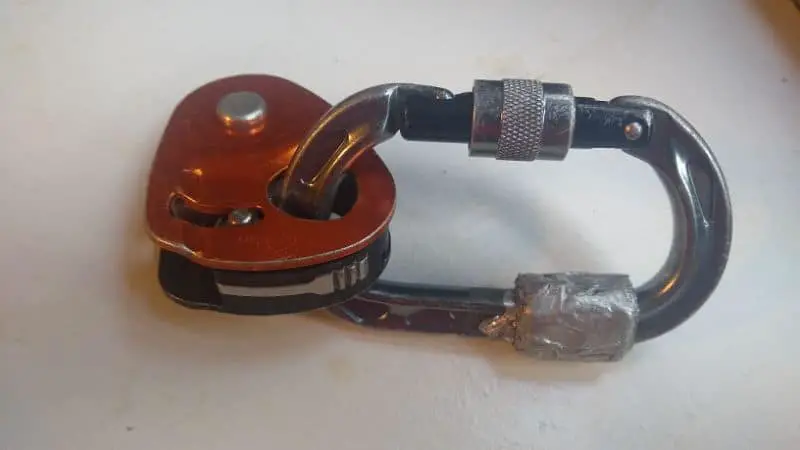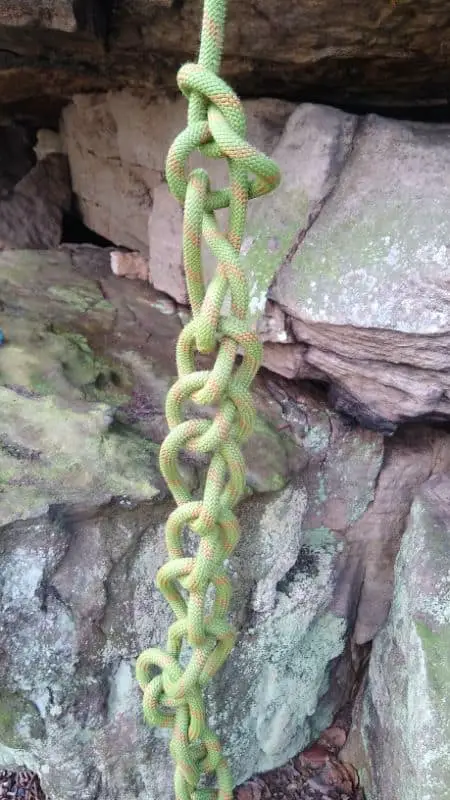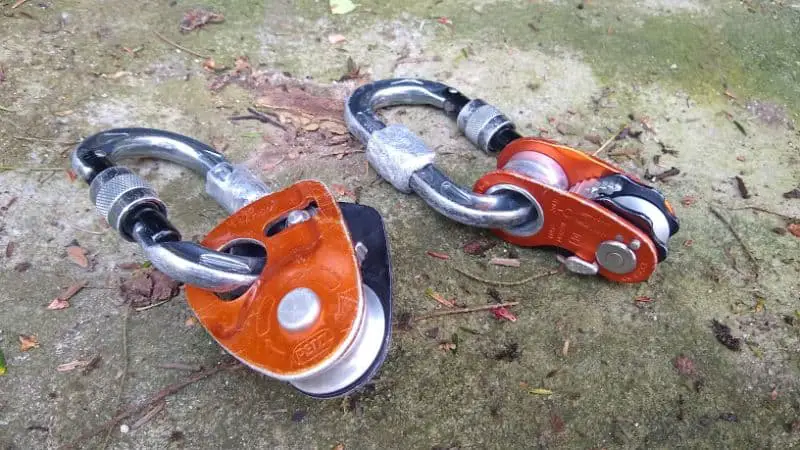What is the best self-belay device for top rope solo climbing?
This is a question without a cut-and-dried answer. The most popular device for top rope soloing is probably the Petzl Micro Traxion (full confession: It’s my chosen device, too).
However, there are several new devices on the market, such as the TAZ LOV2, that might just be game-changers!
But in order to select your own self-belay ascender device for top rope solo climbing, you have to understand what makes a good self-belay device – and that’s what this guide is really about.

Introduction to Top Rope Soloing
Top rope soloing (TRS) is the art of climbing a fixed rope, by yourself, rather than climbing with a partner. It is NOT the same thing as lead rope solo (LRS) or free soloing.
This guide is NOT a full description of the activity and its many, many dangers. As you will see, the system is imperfect, regardless of your equipment. As the British say, “faffing” around with the system requires time, expertise, and patience.
Anyone who wants to climb solo on a top rope should read and memorize the Petzl guide to the activity. Petzl describes multiple techniques and constraints for a safe, redundant climbing system.
For suggestions on the best affordable gear for top rope soloing, you can read my Affordable Gear Guide to Top Rope Soloing.
In this guide, we zero in on a particular piece of equipment: the self-belay device.
Introduction to the Top Rope Solo Self-Belay Device
Because no device is perfect, you must use at least two devices on one rope, or one device each on two separate ropes.

To my knowledge, there are no dedicated TRS self-belay devices on the market. Everything has been adapted from another purpose.
Most so-called self-belay devices were actually designed as one of the following:
- Rope grabs and rope clamps (e.g. Kong Duck)
- Progress-capture pulleys (e.g. Petzl Micro Traxion)
- Ascenders and jumars (e.g. Trango Passport)
- Fall arrest devices (e.g. C.A.M.P. Goblin)
There is no certification standard for a top rope solo self-belay device. Manufacturers must define their own success criteria. That’s a lot of liability and exposure to satisfy a niche market with relatively little commercial reward – therefore, manufacturers haven’t bothered.
Historically, climbers have made do with whatever they have collecting dust in their closets. For instance, many people have TRS climbed with a Petzl Shunt or Petzl GriGri, even though Petzl has explicitly warned (and explained) why these devices are so dangerous for TRS climbing.
That’s why it’s so important to understand what makes a good (or bad) self-belay ascender for TRS climbing. Because ultimately, it’s your choice and your responsibility.
Other devices people have tried include:
- Petzl Rescucender
- Taz LOV2
- C.A.M.P. RollnLock
- C.A.M.P. Goblin
- Kong Duck
- Kong Backup
- Wild Country Ropeman
- Ushba Basic
- Rock Exotica Akimbo
- Edelrid Spoc
None of these devices are designed to catch long falls. Regardless of toothed or toothless designs, most will shred, slice or strip the rope at the higher forces generated by excessive slack or lead falls (3-6 kN).
Why I Picked the Petzl Microtraxion
If you’re looking for the best device to get started in TRS climbing, then the simplest answer is the Petzl Micro Traxion.

(Although the C.A.M.P. Goblin is a well-regarded pick as well.)
Here are the five reasons a Petzl Micro Traxion is my preferred top rope solo self-belay device:
1. Reliable Catch
The design of a Petzl Micro Traxion has been extremely reliable. A toothed cam allows the rope to feed in one direction only; reversing direction will immediately lock up the device.
(I know the word “teeth” isn’t normally used around the word “rope,” but because there isn’t any slack in the system, the teeth don’t damage the rope. I’ve never had my Micro Traxion so much as fuzz the sheath. With that said, falling on an excessively slack rope could cause the Micro Traxion to bite so hard that it cuts through the rope!)
The Petzl Micro Traxion has a working strength of 2.5 kN and a breaking strength of 4 kN when being used as a progress-capture pulley, which is consistent with forces from falling on top rope belay.
The device also works with a variety of rope diameters and on dirty or icy rope.
Plus, it can be attached to a taut line, and it can be left unattended on the rope during a rappel. It is fairly easy to disengage if it jams against the anchor knot, too.

2. Feeds Easily
Unlike my Wild Country Ropeman, my Petzl Micro Traxion will self-feed by simply adding a little bit of weight to the bottom of the rope, like a few coils. It will even feed itself with about 20 feet of rope below it.
3. Nothing to Snag
The Micro Traxion has a cam lock-out lever that converts the device to an idler pulley. However, the button is hard to access and almost flush with the housing – which is perfect! I don’t want buttons or levers that can be grabbed, squished, pushed, or otherwise accidentally engaged. Other devices, like the Shunt, will not perform properly if grabbed and squeezed.
Plus, the rope is completely captured by the side plates, which are captured by a locking carabiner. With other ascenders, such as the Croll, the rope could theoretically pop out at a funky angle.
4. Double Duty as a Pulley
I hate spending money on specialty devices. A Micro Traxion can function as an idler pulley, progress-capture pulley, rope grab, emergency ascender, and TRS self-belay device all in one!
5. Reasonable Cost
At $105 on sale for 25% off, a Micro Traxion isn’t cheap, but it’s not a $400 specialty fall arrestor, either.
Similar progress-capture pulleys include the Elderid Spoc and the Camp Turbolock.
The major complaint about the Micro Traxion is that you must escape the belay in order to rappel. However, as you’ll realize, there’s no such thing as a perfect top rope solo device!
What About Backup Knots?
It is completely unacceptable to climb with a single self-belay device. Any failure can result in serious injury or death. That’s why Petzl mandates two devices if using a single rope.

Some climbers have tried climbing with a single self-belay device backed up by one of three device-less options:
- Stopper knots
- Tie-in knots
- Backup prusiks
Here are some challenges with this system.
Stopper Knots
Not only are stopper knots time-consuming to tie and likely to get snagged, but if your primary device fails and you whip 15 feet before your belay device jams into the nearest stopper knot, the force of the impact could shatter your belay device completely!*
However, stopper knots are commonly used by climbers who rely on fall arrester devices rather than rope clamps or progress-capture pulleys. This is because a fall arrestor, unlike a rope clamp, doesn’t immediately catch a fall. Inertia is required to engage the cam. Therefore, the primary device could slide down onto the secondary device, rendering them both inoperable. A stopper knot merely jams into the fall arrestor to halt the fall.
If you insist on using stopper knots with a single device, one safety improvement is to run the rope through a small 10mm steel quick link attached to your tie-in points using a basketed nylon sling or eye-to-eye tether. The quick link must be just large enough for the rope, and not the knot, to feed through. This quick link, instead of the self-belay device, will jam against the stopper knot.
Relying on stopper knots as a backup requires a dynamic rope, which is not normally recommended for top rope soloing. Even if a static rope were to survive the fall, the shock forces could cause severe or fatal damage to your internal organs.
Interval Tie-In Knots
Periodically tying into the rope is safer than stopper knots, but very cumbersome. The preferred method is to tie alpine butterfly loops and attach using a steel triple-locking carabiner. You have to stop, unclip and retie the knots every 10 feet or so, which is exasperating even in the best conditions.
Relying on tie-in knots as a backup requires a dynamic rope, which is not normally recommended for top rope soloing. Even if a static rope were to survive the fall, the shock forces could cause severe or fatal damage to your internal organs.
Backup Prusiks
Prusiks are not suitable for backups for several reasons:
- Nylon cord can melt at very low temperatures from friction, whereas aramid or high-strength polyethylene cord is sensitive to shock.
- Slide-and-grip knots don’t self-tend, and several will fail if grabbed during a fall.
- Lastly, if your primary device jams against the top of the prusik wraps, it may fail to cinch!
***
None of these backup methods are recommended by any manufacturer, certification group or guide that I know of. I mention them only for educational purposes.
What Makes for a Good Top Rope Solo Device?
Let’s consider some criteria for evaluating a device to be used as a TRS self-belay ascender. As a climber adventuring alone, you’ll be responsible for understanding the limitations of your equipment.
Strength In a Fall
Climbing on top rope isn’t the same as conventional roped climbing. In conventional climbing, the brunt of the fall force is taken by the top piece of protection. Rope slippage at the belay device dissipates energy at the belay, and the “squishiness” of the human body dissipates energy at the climber.
But in top rope solo climbing, the forces are concentrated at the self-belay device. The device will at least take your body weight (and then some for the extra momentum). Even falls on relatively little slack can generate forces of 2+ kN.
That’s why compact rope clamps, like the C.A.M.P. Lift or Petzl Tibloc, are not recommended for TRS climbing. They have relatively little margin of safety. I look for something with at least 4 kN (~ 900 lbs) breaking strength.
Performance Sensitivity
Think of performance sensitivity as the “bomberness” of the device. You’re mainly looking at two things:
- Is the device sensitive to orientation?
- Can a different mode be accidentally activated?
A good device will lock up no matter how you take the fall – sideways, straight up, straight out, on a slab, on an overhang, etc.
Remember, your system must catch your falls 100% of the time. 99.99% isn’t good enough; 0.01% will kill you!
Here are some questions to evaluate the sensitivity of your device:
“No” Questions
- Can the device be accidentally locked or opened?
- Are there any handles or levers which could be accidentally pulled?
The correct answer is “No” to all these questions. If the answer is “Yes,” then the device is not appropriate for top rope solo climbing.
“Yes” Questions
- Will the device still engage if the carabiner is cross-loaded?
- Will the device still engage if it collides with another device?
- Will the device still catch on a diagonal rope or a traverse?
- Can the device be attached or removed mid-line?
- Will the device hold slab, overhanging, and upside down falls?
The correct answer is “Yes” to all these questions. If the answer is “No,” then the device is not appropriate for top rope solo climbing.
Smoothness of Rope Feeding
Some devices feed more smoothly than others. Devices with pulley sheaves and bearings feed like a dream.
Almost no device will feed properly at the start of a route without some extra weight at the bottom of the rope. Here are some options for adding weight to your rope:
- Tie an alpine butterfly loop and clip a water bottle or backpack into it.
- Coil the rope and hang it above the ground.
- Make a daisy chain sinnet and hang it above the ground.

If you don’t add weight to your rope, you’ll have to manually pull slack through the device for the first 20-50 feet (depending on your device and rope), which is extraordinarily dangerous!
Devices or methods that don’t consistently self-feed, such as the Petzl GriGri, the clove hitch knot, and any guide-mode tubular belay/rappel device, are not appropriate for top rope soloing. As you climb, you’ll introduce slack into the rope. Falling on a slack rope can generate tremendous forces and break your device or cut your rope!
Durability
Many climbing devices use forged aluminum for the body (for weight savings) and stainless steel for the wearable components (for long life).
All-aluminum construction is lighter, but aluminum wears quickly, especially in sandy environments.
When my Micro Traxion eventually wears out, I will likely search for an alternative with stainless steel wearable components.
Progress Capture Ability
Imagine a conventional belay device, like an ATC. By design, a belay device doesn’t catch instantaneously. A certain amount of rope slips through the device to dissipate energy through friction before it locks off.
That’s perfect for conventional belay devices; not so great for top rope solo device. Any significant rope slippage can shock-load the ascender and drop you lower on the route.
This is one reason conventional fall-arrest devices haven’t become hugely popular for top rope soloing. Check out the Petzl ASAP, a well-regarded fall arrest device:
ASAP – ASAP LOCK – Mobile fall arrester for rope – YouTube
As you can see, the ASAP locks under inertia. If used for top rope soloing, the device wouldn’t immediately catch a fall, and the climber would lose valuable vertical terrain. Accidentally unweighting the device after a fall will repeat the fall-arrest cycle.
Similar devices include the CAMP Goblin, Wild Country Revo, MIO Rope Grab, Kong Back-Up, etc. Some of these devices, like the CAMP Goblin, seem to have the “sweet spot” for climbing and don’t require large falls to engage.
Some fall-arrest devices, like the MIO or Back-Up, require manual adjustment to move down the rope (such as for downclimbing).
And several of these devices will not hold a fall if grabbed with a hand – very dangerous for top rope soloing!
Weight & Size
As climbers, we like the smaller, the better!
Here are some weights for references:
- Petzl Micro Traxion: 85 grams
- Petzl Ascension: 165 grams
- C.A.M.P. RollnLock: 80 grams
- C.A.M.P. Goblin: 280 grams
Generally, fall arresters are significantly heavier than recreational rock climbing equipment. Most climbing devices used for top rope soloing weigh less than 150 grams.
Rope Versatility
The ideal ascender for top rope soloing will work with a variety of rope types, thicknesses, and conditions:
Here are some questions to ask yourself:
- Will it catch on slim 9.2mm climbing rope or skinny canyoneering 8.5 mm rope?
- Will it catch on beefy 10.5mm gym climbing rope or fat 13mm arborist rope?
- Will it catch on wet rope?
- Will it catch on icy rope?
- Will it catch on fuzzy rope?
- Will it catch on dirty or sandy rope?
Ease of Switching to Rappel
Unfortunately, most devices used for TRS climbing do not have a “rappel” mode. This is because rappel devices allow rope to slide under load, and this is exactly what you don’t want when top rope soloing!
While I haven’t used it myself, there’s been a lot of excitement around the TAZ LOV2, a fall arrest and descender for diagonal or tight or regular ropes. With the LOV2, no changeover is necessary – it’s a descender and fall arrester all in one!
However, the LOV2 will not hold an upside-down fall (and therefore requires a chest harness), and the handle could be snagged by clothing or rock.
A similar device is the Rock Exotica Akimbo, but there is concern about the device snagging or being grabbed during a fall.
As of today, the ideal all-in-one TRS device doesn’t exist. In general, you must escape the belay in order to rappel.
(Progress-capture devices even require you to escape the belay just to downclimb. No downward movement is otherwise possible!
This is why some climbers climb with a secondary rope with a pre-rigged rappel device.)
Some devices, like the Petzl Micro Traxion, can be left on the rope while rappelling. The Traxion cam must be locked out in the “idler pulley” mode; this will allow it to slide down the rope. Most simple rope grabs don’t have this ability; they must be completely removed from the rope, and some cannot be removed from a line under load.
Generally, this means you must also carry:
- A second rappel device (e.g. Black Diamond ATC)
- A rappel safety backup (e.g. Sterling HollowBlock)
- A prusik or rope clamp to tether yourself above the TRS self-belay device and unweight the rope.*
*Pro Tip: A VT prusik has the unique ability as a slide-and-grip knot to slide down the rope even when one or both is under load, which makes it ideal for the changeover!
Cost
Ah, and finally, the ideal top rope solo device is free of charge!
A simple rope clamp like the Kong Duck might cost as little as $50. A Petzl Micro Traxion currently retails for $130, whereas most fall arrestors cost $200 and up.
While I understand the cost is important (this is Adventure On the Cheap, after all), cost belongs at the bottom of this list.
For one, it is far wiser to spend the extra money on a multi-purpose device than a simple device that can only do one thing …
And for another, this device will become your constant friend and companion for years, maybe decades. In the same way that you don’t buy a cheap mattress, you don’t buy cheap climbing gear.
You’re trusting your life to this device. Is your life worth the extra $50?
Gear Takeaways
In conclusion, the Petzl Micro Traxion has earned a reputation as a reliable self-belay ascender for top rope solo climbing. I use a C.A.M.P. RollnLock as my backup because it has ridges rather than teeth.

Simple rope clamps and jumars aren’t suitable for TRS climbing because they drag rope and lack ultimate strength.
Fall-arrest devices like the CAMP Goblin are actually certified for similar uses, while arborist tools like the Rock Exotica Akimbo offer climbers the ability to climb, downclimb and rappel without escaping the system.
Use two devices to self-belay as you ascend a semi-static rope[s]. Ensure the two do not and cannot interfere with each other!
Be safe!

